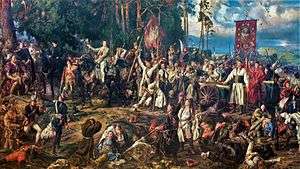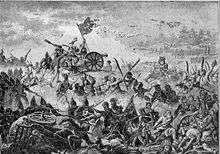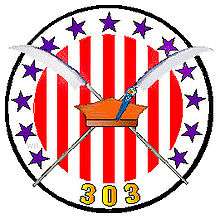Battle of Racławice
The Battle of Racławice was one of the first battles of the Polish-Lithuanian Kościuszko Uprising against Russia. It was fought on 4 April 1794 near the village of Racławice in Lesser Poland.[1]:185
| Battle of Racławice | |||||||
|---|---|---|---|---|---|---|---|
| Part of the Kościuszko Uprising | |||||||
 "Battle of Racławice", Jan Matejko 465 × 897 cm. Kraków's National Museum. | |||||||
| |||||||
| Belligerents | |||||||
|
|
| ||||||
| Commanders and leaders | |||||||
|
|
| ||||||
| Strength | |||||||
| 5,000[1]:185 and 11 cannons | 3,000[1]:185 and 12 cannons | ||||||
| Casualties and losses | |||||||
| 200-250[1]:186 | 800[1]:186 | ||||||

The battle site is one of Poland's official national Historic Monuments (Pomnik historii), as designated May 1, 2004. Its listing is maintained by the National Heritage Board of Poland.
Battle
General Denisov, with 2,500 troops, had planned to attack the Poles from the south, while Tormasov's force of 3,000 troops blocked Kosciuszko.[1]:185 Encountering Tormasov's force first, Kosciuszko occupied a nearby hill, General Antoni Madalinski on his right and General Józef Zajączek on his left.[1]:185 Not waiting any longer, Tormasov attacked the hill by 3:00 PM, setting up their cannon.[1]:185 Kosciuszko inspired his peasant brigade with shouts of "My boys, take that artillery! For God, and the Fatherland! Go forward with faith!"[1]:185
The first group of serfs captured three twelve-pound cannons and the second wave captured eight more cannons.[1]:186 Moving to his left flank, Kosciuszko led a bayonet charge when the Russians fled, followed closely by the scythemen.[1]:186
The Polish Order of Battle was as follows:
| unit | superior | soldiers | |||||||||||
|---|---|---|---|---|---|---|---|---|---|---|---|---|---|
| 2 battalions | Infantry Regiment of Czapski | 400 bayonettes | |||||||||||
| 2 battalions | Infantry Regiment of Wodzicki | 400 bayonettes | |||||||||||
| 2 battalions | Infantry Regiment of Ożarowski | 400 bayonettes | |||||||||||
| 1 battalion | Infantry Regiment of Raczyński | 200 bayonettes | |||||||||||
| 10 squadrons of cavalry | under Antoni Madaliński | 400 sabres | |||||||||||
| 10 squadrons of cavalry | under Magnet | 400 sabres | |||||||||||
| 4 cavalry squadrons | under Biernacki | 160 sabres | |||||||||||
| 2 auxiliary cavalry squadrons | Duchy of Württemberg | 80 sabres | |||||||||||
| 2440 men altogether | |||||||||||||
In addition, Lesser Poland fielded approximately 2,000 peasants armed with war scythes and pikes, known as kosynierzy, as well as 11 cannon. The outcome of the battle was a tactical Polish victory, with Kościuszko defeating the numerically inferior enemy. However, his forces were too small to undertake a successful pursuit, and the Corps of General Denisov evaded destruction and continued to operate in Lesser Poland.
Aftermath
Kosciuszko marched back to Kraków and made camp in the fields of Bosutow.[1]:185

After the battle, Kościuszko paraded before his troops in a sukmana, a traditional attire worn in Lesser Poland, in honour of the bravery of the peasants, whose charge ensured the quick capture of the Russian artillery.[1]:186 He also praised Wojciech Bartosz Głowacki, a peasant who was the first to capture the cannon (he is visible in Matejko's painting, above).[2] He smothered its fuse with his hat before it fired.[1]:185 In return he received an award of nobility, his freedom, a tract of land and made standard-bearer.[1]:186
The victory was subsequently promoted in Poland as a major success and helped in spreading the Kościuszko Uprising to other areas of Poland and instigating the Warsaw Uprising of 1794. Also, the participation of peasant volunteers was seen by many as the starting point of the political evolution of Polish peasantry from serfs to equally entitled citizens of the nation.
Legacy
Both the red cap worn by his soldiers and the homemade war scythes were later featured on the emblem of the RAF's 303 (Polish) Fighter Squadron, which took part in the Battle of Britain.
The Battle of Racławice is commemorated on the Tomb of the Unknown Soldier, Warsaw, with the inscription "RACŁAWICE 4 IV 1794".
References
- Storozynski, A., 2009, The Peasant Prince, New York: St. Martin's Press, ISBN 9780312388027
- Smaczniak, Anthony; Piotrowski, Wallace (2000). "The Military Genius of Tadeusz Kosciuszko". Info Poland. Polish Academic Information Center, University at Buffalo. Archived from the original on 13 July 2012. Retrieved 2 August 2012.
See also
- The Racławice Panorama